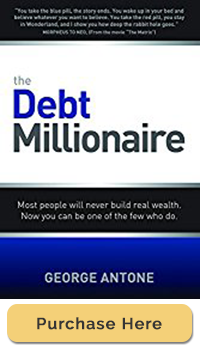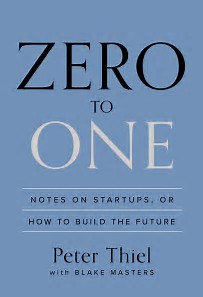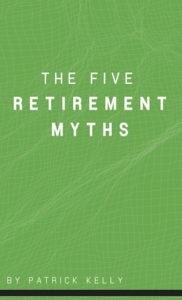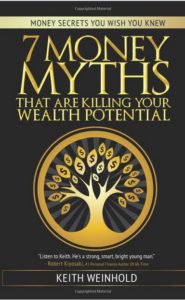
A book review of The Debt Millionaire
In a nutshell, The Debt Millionaire, by George Antone, is a good book on the impact of inflation, taxes, opportunity cost, and interest on the typical investor/saver. An overriding principle of this book is presented as follows:
There are two sides to every financial equation, the left side (the paying side) and the right side (the receiving side).
According to Antone, most people are on the left side of the equation (they pay, but don’t receive), and they stay there all their lives. The wealthy have moved to the right side of the equation.
The sooner we can move to the right side of the wealth equation (the receiving side), the sooner we can benefit.
Antone mentions that the right side benefits in four distinct ways:
- Interest payments,
- Inflation,
- Lower taxes, and
- Minimizing the opportunity cost of their cash.
While those on the left side of the equation suffer from all four of those financial “forces.” The way to move to the right side of the equation, is by using DEBT. This is really the crux of the argument in the book:
Debt is the tool that enables individuals to move to the right side of the equation.
But he differentiates between good debt and bad debt. So don’t assume you can run out and rack up a bunch of credit card debt and pat yourself on the back for having moved to the right side of the financial equation.
But he also states quite plainly that it is very difficult (if not impossible) to beat inflation and taxes without using good debt.
He says most people are concerned with finding the right asset, but they should instead be concerned with finding the best financing. This will increase their wealth much quicker and with less risk.
…most people are concerned with finding the right asset, but they should instead be concerned with finding the best financing.
The book is probably best read in conjunction with his other two books The Wealthy Code and The Banker’s Code since they are frequently referenced in The Debt Millionaire.
Who is this book for?
If you recognize that the use of debt CAN HELP you achieve your financial goals faster, but CAN ALSO DESTROY you if not used properly, then this book is a MUST read for you.
The Wealth Equation
The book begins by providing The Wealth Equation, which is that all financial transactions have a paying side (left side) and a receiving side (right side). This is also called the WealthQ Method in the book.
In the equation X + Y = Z, where X is $6 and Y is $5, Z must be $11. The paying side is the left side of the equal sign. They pay their $6 and their $5 to the person on the right side of the equation.
Antone states:
If most people are on the “Paying” side of the major forces above, then who is on the “Receiving” side? The financial institutions and the ultra-wealthy are, as shown in the next table…By simply moving yourself to the right side of the equation, you will start increasing your net-worth automatically while being on the same side as the financial institutions and the ultra-affluent.
and
Using the WealthQ Method you will end up investing in relatively safer assets than the people on the left side. You will have more liquidity (more capital in the bank), and build your net-worth faster than the people on the left side! On the right side the system works in your favor!
Ultimately this method (the WealthQ Method) is about a change in perspective. The goal isn’t increased returns or buying larger assets.
Antone does an excellent job of providing the reader with:
9 Considerations for Growing Wealth
1: Cash
You know the $10,000 won’t build wealth sitting there in cash under your mattress. You need to make it work for you. So what do you do? Odds are high that you will invest it.
I&E: We would recommend you consider sticking your cash into tax favored dividend paying whole life insurance.
2: The Compounding Environment
You’ve been told that compounding interest is the eighth wonder of the world and therefore you just need to get the ball rolling. Don’t worry about the details, just jump in and get going.
So what happens next? Well, there’s taxes.
3: Tax Environment
3 different tax environments:
- Tax-Free Compounding Growth
- Tax-Deferred Compounding Growth
- Taxable Compounding Growth
A penny doubled every day for 30 days in the three environments above produces the following results:
- Tax-Free Compounding Growth: $5,368,709.12
- Tax-Deferred Compounding Growth: $3,758,096.38 (assuming 30% bracket)
- Taxable Compounding Growth: $48,196.86 (assuming 30% bracket)
But this isn’t the entire picture. Keep in mind that someone is probably making some money off managing your investment, which brings us to fees.
4: Fees
Antone is referring to the financial system fees (banks, fund managers, big finance, brokers, etc.). Those that are not actually putting up any of the money, are getting fees because they maintain the infrastructure, but you maintain all the risk. They charge a percentage, and as you save more and more money, they earn more in more via fees.
In a rather brutal example of the financial fees at work, Antone states the following in reference to an investor getting an 8% annual return on a one time investment of $1000 and allowing it to compound for 65 years:
…the mutual fund system in this case—will take about two and one half percentage points out of that return, so you will have a gross return of 8%, a net return of 5.5%, and your $1,000 will grow to approximately $30,000.
$110,000 goes to the financial system and $30,000 to you, the investor.
Think about that. That means the financial system put up zero percent of the capital and took zero percent of the risk and got almost 80% of the return, and you, the investor in this long time period, an investment lifetime, put up 100 percent of the capital, took 100% of the risk, and got only a little bit over 20% of the return.
5: Inflation
Even at a relatively low 3% inflation rate, prices double roughly every 25 years.
Antone argues in favor of a much higher rate of inflation due to the fact that the CPI (Consumer Price Index) was changed during the Carter and Clinton administrations to remove both food and gas from the index. Obviously we need both of these things to live a rather normal life, so it’s odd to remove them. If you add them back in, inflation floats around 10%, not at 3%.
What does this mean? It’s not good. Your return on investment needs to meet out 10% after taxes and after fees, every single year, just to maintain its purchasing power, and your investment has to be growing in a compounding manner!
6: Opportunity Cost
Antone writes,
When you “park” your money in an account that grows in a compounding manner, you are losing the opportunity to make more money with that money. In fact, it is your biggest cost, bigger than any other cost.
I&E: Making money with money is one of the key strengths of the infinite banking concept®.
7: The Break-Even Return Equation
If we invest in a compounding environment (who wouldn’t want this incredible force working for them?), we discover that it isn’t enough to outpace inflation, so we put it in the right tax environment, but still find out that it isn’t enough. So we minimize fees, and we even assume that we will get a consistent return every year. But ultimately it’s not enough.
Antone concludes, based on a 40% tax bracket (including state and federal together) and 10% inflation (perhaps a bit high, he admits) that your return on an initial $10,000 investment would need to be 16.67% in order to break even, or maintain purchasing power.
His point is that so many things are stacked against you as an investor.
And it gets worse.
8: Balanced Portfolio
Antone writes,
If your break-even rate was 16.67% as in our example, and you diversify half of your portfolio into “safer” assets such as bonds yielding 2%, that means the other half of your portfolio has to generate a crazy impossible return year after year in a compounding manner just to break even, not to build any wealth!
9: Financial Leverage
The truth of the matter is this: You cannot build real wealth without the use of LEVERAGE. Leverage is the true 8th wonder of the world, not compound interest.
The so-called “gurus” on TV will argue against leverage, but those that are affluent say they can’t live without it.
The secret to moving to the “Receiving” side of the WealthQ is well-structured leverage!
But not all leverage is created equal. The key is correctly structured leverage, which includes both the terms and the amount of leverage. Ultimately it should be a replicating process.
Hacking the System
We “hack” the system when we counter the “forces” mentioned earlier (Interest, Taxes, Opportunity Cost, and Inflation). Debt is our weapon against these forces, and it works because it is the base that all the monetary system was built upon.
Simply put, “good debt” is debt that we use to purchase assets that appreciate or pay us regularly, or both.
In contrast, “bad debt” is consumer debt that takes money from our pocket, such as credit cards, auto loans, etc.
Against Conventional Wisdom
This section of the book, Hacking the System, took a bit to wrap my head around, because it confronts some of the conventional wisdom.
Antone states that you don’t go into debt for the sake of buying an asset, but rather to get into well-structured debt.
And here is an example of what he means:
By using the $200 per month to pay against the loan, you are essentially “saving” 6% (in this example), which is similar to making 6% tax-free. So taxes work to our advantage—i.e. we are not paying taxes on “saved” money… By using debt, you are using other people’s money to buy the asset, and not our money.
That means you are not losing the opportunity of buying the asset in the future for all cash, you are buying it today. Since you are using debt to buy the asset today, and you are paying for it over time, you are using the “time value of money” to your advantage.
That essentially means you are paying for it with future money. The $200 payments are spread out over many years which means it is “cheaper” money. This allows you to use inflation to your advantage.
In order to oppose the four forces mentioned above, you have to move to the right side of the equation in each area.
Moving to the Receiving Side of Interest
Albert Einstein said, ‘Those who understand interest, earn it, those who don’t, pay it.’
34.5% of the average American’s take-home income goes to financial institutions just to cover interest. People are not working for themselves, they are working for the bankers!
Antone says there are three “teams” in this world: consumers, producers, and bankers.
Consumers pay interest, and they end up being the slaves to the system—working to pay off “created” money that doesn’t exist! … To be on the “Receiving” side of interest, you can be either the banker or the producer. You can either create interest or pass it on and make money off of it.
Jack, the consumer, is needed to drive the economy. He is on the “Paying” side of interest. The banker was on the “Receiving” side, and so was the producer, creating an “arbitrage” situation—borrowing money from the banker and passing the interest cost on to Jack the consumer and then keeping the profit.
Now it seems as though the banks have everything going for them, but hold on. When they lend money for 30 years at a low interest rate, inflation works to their disadvantage. They are lending money out today, in order to receive interest for 30 years. But the money paid in the future is worth far less than it is today, so it’s possible that even though they are on the “receiving” side of interest, they are also on the “paying” side of inflation.
According to Antone, there are three ways to avoid being on the “paying” side of inflation once you are on the “receiving” side of interest.
- Lend money at an interest rate that is higher than the inflation rate after taxes.
- Borrow money at a lower rate and lend it out or invest it at a higher rate.
- Use the “velocity of money” to turn money around as it comes in to increase your overall yield.
So how did bankers get out of the “paying” side of inflation, with regard to the mortgage industry?
They sold their mortgages to Wall Street. So they lend money to the consumer and move to the “receiving” side of interest, but they also borrow from Wall Street (by selling the mortgage-backed securities) in order to avoid being on the “paying” side of inflation. The owners of the securities are the individuals that need to be concerned about inflation now.
Moving to the Receiving Side of Opportunity Cost!
In fact, it’s believed that the biggest cost to the average American, more than taxes and inflation, is opportunity cost.
Opportunity cost example: If you have money to buy a car with cash, but instead you financed the car at 3% and invested the money with a 6% return, you would have made a 3% (difference/spread) profit. This difference, or spread as it is referenced in the book, is the key to the opportunity cost side of the equation.
Here’s a good opportunity cost example from the book of a person with $50,000 in cash:
Let’s assume you invested that $50,000 as down payment into purchasing a $250,000 rental property. That money now is locked up for some time, say five years or more. Let’s assume your return is X%.
However, that money is now locked up, and you have no liquid funds to invest, therefore your chances of obtaining another loan from a lender to purchase another asset have declined significantly (due to lack of liquidity).
On the other hand, if you kept that $50,000 in your liquid account and brought in an equity partner to put up the down payment for a piece of the upside, now you are a part owner of the property and you still have your $50,000. …
That is the difference between looking for a “return” and a “spread”. When you invest your money, you are looking for a “return,” but you lock up your money and lose the opportunity to make more money with it.
Looking for a “spread” allows you to make more money using other people’s money and you also have the ability to do many [more spreads]. So in essence, that $50,000 in your liquid account allows you to generate many more “spreads” than “returns.”
For mortgages, Antone recommends using a traditional 30 year mortgage at a minimum of 80% loan to value with the lowest fixed interest rate you can find. HELOC’s should only be used for short term deals and/or for a period of time in order to acquire an equity partner.
Moving to the Receiving Side of Inflation
Real dollars are also known as “inflation-adjusted” dollars. Whereas nominal dollars are known as “countable” dollars. Most people think in terms of nominal dollars. They don’t consider inflation into the equation.
The first thing to do to move over to the right side of the Wealth Equation is for you to start looking at and thinking in terms of real dollars.
In this section of the book Antone makes in clear that the appreciation of the asset is not the best way to profit, but instead it is the loan. The loan is the “secret sauce” to profiting from inflation. The key is to pick the right loan.
Debt allows you to buy an asset today, but pay for it in the future. The reason this is important is that this is where nominal dollars and real dollars come into play. When you buy an asset today using well-structured debt, you are buying it with real dollars today, but paying for it in nominal dollars in the future!
The key here is that when you borrow to buy a real asset, like a house, the house is real, so it increases in value along with inflation. BUT the loan is paid back in nominal dollars. Your payment is fixed for 30 years. So the $1120 payment made today, is going to be the same payment made in 30 years, but the dollars will be worth much less. If the interest rate is low, say 4% or less, you will easily beat out the real rate of inflation.
The left side buys assets thinking it is the assets that make them rich. The right side creates debt with the right assets because they know it is the debt that makes them wealthy.
Lowering Your Taxes
The key is to have as much of your investment growing in a tax-deferred or tax-free environment.
Antone recommends four components to a Tax Management System:
- Team – These are the people that will be involved in all aspects of your system to help you increase your net-worth and save you money.
- Plan – This is a plan customized by your tax strategist. It should include what to use and how to use them.
- Vehicles – this is whatever your strategist thinks will work best for you, including trusts, qualified plans, banking systems, etc.
- Processes – All the things needed to be in place in order for the system to run efficiently; filing, tracking, documentation, verification, bookkeeping, etc.
It’s likely your team will have 3 members on it, the Tax Strategist, the Accountant, and the Bookkeeper. Collectively these three are called your Tax Management Team
In order to accomplish these goals you need to work through the following 5 phases.
- Team Building – obviously the first step is to assemble the team.
- Evaluation – meet with strategist to go over financials and determine where you are currently.
- Planning – meet with the tax strategist and come up with a customized strategy just for you. Goal should be to save on taxes and help position financials to facilitate borrowing for the purpose of investing.
- Strategy – Once you have the plan, you put it into practice
- Management – This is the ongoing process of following up on all that is happening in the system
The Last & Most Important form of Leverage
Knowledge is the most important aspect of the Wealth Equation. No matter how much you implement the information in this book, without understanding how to THINK about your finances, you will likely end up no better and perhaps even worse off than where you are today.
The most important leverage of them all is KNOWLEDGE. And the most effective way to transfer your financial knowledge is through the family bank concept.
The family bank concept, AKA infinite banking, is a great way to pass along financial knowledge from one generation to the next. Antone doesn’t talk about the family bank concept in the book very much, but that’s only because he likely discusses it at length in his other book The Banker’s Code.
Antone mentions that he loves gathering in small mastermind groups with like-minded people to discuss these topics and others. I highly recommend this practice and can say it has helped me quite a bit. If for no other reason that to be encouraged in your financial endeavors, it is good to meet with others and discuss these things in an environment that is free of fees and degrees.
There is plenty more in the book that I have intentionally left out for the purpose of keeping this review somewhat manageable, so I recommend picking up a copy (or download it from Amazon like I did) and reading it for yourself.





